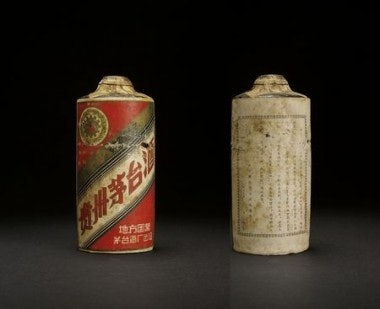Vintage Bottles Of Maotai Selling For Hundreds Of Thousands Of Dollars At Auction#

This bottle of 1958 Moutai sold last year for $220,000
With prices for Moutai (茅台), China's most popular brand of premium baijiu (distilled sorghum spirits), spiking in recent months amid soaring demand and ostensibly dwindling supply, and rampant counterfeiting causing the company to release special imprints with extreme security features, the country's fever for high-end Chinese "white lightning" is now starting to light up the auction market. Much as Chinese collectors have caused prices for favored wine vintages like Chateau Lafite '82 to skyrocket at auction in Hong Kong to "insane" levels, well-heeled Moutai lovers are bidding hundreds of thousands of dollars for rare vintage bottles, prices that only a few years ago would have seemed outlandish. In response to the swelling demand for 1950s and '60s Moutai, domestic Chinese auction houses are now scouring the country, "Antiques Roadshow"-style, searching for old bottles.
Despite the far lower demand for baijiu outside of China -- bottles of Moutai can be procured in New York's Chinatown for around half of what they'd cost in China -- in China rare or expensive bottles carry a prestige that's hard to overstate. A recent article in the New York Times about the spiraling price and demand for Moutai in China neatly sums up the motivation that many in China have for sometimes spending the equivalent of the average Chinese laborer's annual wage on a single bottle of spirits:
“Moutai has become China’s Louis Vuitton,” said Liu Yuan, general secretary of the National Association for Liquor and Spirits Circulation, a trade group. “Given the limited output and steep price, it’s a good way for officials to curry favor and for the rich to show off their wealth.”
If a recent vintage of Moutai is akin to a Louis Vuitton handbag, for a growing number of wealthy collectors, vintage Moutai is the equivalent of the Hermès crocodile-skin Birkin. More difficult to counterfeit, and given the nod of authenticity by an established Chinese auction house, vintage bottles of baijiu are highly sought-after commodities in the auction market. Perhaps nothing can make as much of an impact on a government official or business partner as whipping out a very rare bottle of 50-year-old Moutai to seal a deal. Collectors, of course, know this, and they've proven that they're willing to spend. Late last year, a bottle of 1958 Moutai sold at auction in Hangzhou for 1.45 million yuan (US$220,000), setting a new record, and more recently, a 1959 vintage sold at auction for $152,000. What makes these bottles so special? Besides their age, as Jing Daily pointed out last December:
Moutai baijiu is one of the most lucrative products manufactured in the relatively poor province of Guizhou, which was hit particularly hard by the Great Famine of 1958-1961. But, as one would expect, during those tragic years, production of Moutai — which requires at least 12 jin (13.23 pounds) of precious sorghum grain per bottle — was strictly limited, and these vintages are naturally much harder to come across nowadays.
On the search for rare bottles (particularly those produced between 1958-1961), recently Shanghai Auction invited more than 600 elderly Shanghai residents to bring in their vintage bottles of baijiu for appraisal. Of the hundreds of bottles brought in, the auction house will put 110 on the auction block next Sunday, a few of which are expected to sell for more than one million yuan (US$152,000). From China.org.cn:
[At the] auction on Sunday, a bottle of 1955 vintage, the earliest ever seen on the market, stands a good chance of breaking the existing price record and winning the crown of "the most expensive Moutai" in China.
"The bottles for auction are collected from more than 600 residents across the city," said Fan. "More people are sending in their collections than we expected - around 500 people came in less than two days, and most of them are senior residents."
According to Gan, the upcoming Moutai auction will also be the first time that such a large number of the goods for auction came from the grassroots level.
"A decent bottle of Moutai, especially the ones produced by the renowned Kweichow Moutai company, was a good gift to give for weddings during the 1960s and 1970s, which is why the older generation usually kept them as souvenirs," said [Fan Ganping, vice-president of the auction house].
"Someone came to me hoping to auction two bottles of Kweichow Moutai, which he purchased for 3.5 yuan each in 1966. I think they will easily sell for 300,000 yuan each. Never in his wildest dreams would he expect such a big increase in value."
Whether the vintage Moutai market continues to heat up really depends on the supply. For certain, highly sought-after vintages, such as those produced during the agricultural disasters of the late 1950s and early 1960s, experts say that relatively few bottles are actually left. Recently, a Moutai representative said that there are less than 20 bottles of the 1958 vintage left in existence, and that several of these bottles reside in the cellars of the Moutai factory for safe-keeping. So the big question is whether counterfeiters will move in, creating more bottles of certain vintages than even exist. As we've seen in the case of Chateau Lafite, upwards of 70 percent of which is estimated to be fake in China, it's probably best to expect the unexpected.